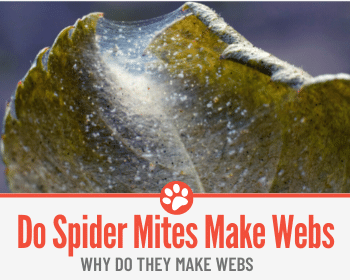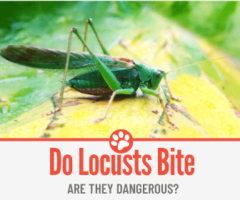 Oh no! Once again I have a spider-mite invasion! I knew I should have quarantined that beautiful Parlor Palm my sister gave me. Hmmmm, could this be sabotage with the old sibling rivalry rearing its ugly head again….?
Oh no! Once again I have a spider-mite invasion! I knew I should have quarantined that beautiful Parlor Palm my sister gave me. Hmmmm, could this be sabotage with the old sibling rivalry rearing its ugly head again….?
But this is one of the most common ways to get spider mites on your plants so I thought I’d share with your my in-depth knowledge about these little terrorists and just how they like to wreak havoc on our much-loved plants – especially house plants.
Do Spider Mites Make Webs?
Yes, spider mites most certainly do make webs. The spider mite is classed as an arachnid and therefore related to spiders (and ticks – ewww!). Therefore, spider mites do make webs just like regular spiders.
Why Do Spider Mites Make Webs?
The reason spider mites make webs is to protect their extended family – yep, including the in-laws – and to protect the eggs so that other bug predators can’t get at them. The web acts in the same way as a regular spider web by trapping would-be predators and there, within the web, the would-be predator will eventually die, whilst that happy little spider mites rapidly extending family blissfully munches away at the foliage, doing their level best at destroying the plant.
Do ALL Spider Mites Make Webs?
Yes, all spider mites make webs and the webs all appear the same whether the mite itself is, brown, red or white.
What about Predatory Mites
No, predatory mites do not make webs as they are a different kind of bug and do not belong to the arachnid family. Predatory bugs of spider mites include phytoseiulus persimilis, amblyseius californicus and amblyseius andersoni.
Can Spider Mite Webs Kill Plants?
The spider mite web itself doesn’t kill the plant, but the spider mites most certainly can if an infestation isn’t addressed in the early stages. They attack the plant by penetrating the outer walls of the stems and leaves to get at the sweet, sugary sap within. Eventually the poor plant loses its energy and nutrients and unless exterminated, the spider mite will continue to munch through the plant until it eventually gives up and dies.
Can You Even See Spider Mite Webs?
Yes, you can usually see spider mite webs if you look closely, especially underneath the leaves where they might just be starting to form. The spider mites themselves are a bit more difficult to see with the naked eye so maybe use a magnifying glass.
What Do Spider Mite Webs Look Like?
The spider mite web appears like a very fine silk veil on the underside and/or between the leaves and will eventually become more visible as they extend over the top of the leaves and start to take over the plant. The spider mite itself is tiny, coming in at less than 0.05 inches – about the size of the sharp end of a pin – so that’s why they can be very hard to see with the naked eye.
The spider mite can be different shades or red, brown and even white in colour and they have an oval-shaped body. Once they have started feeding on your treasured plant, you will start to see little light coloured spots on the leaves and stems, which is where the spider mites have sucked out all the tasty juice and that area of the poor plant is left with no life.
You will probably notice that leaves start to turn yellow and brown as they start drying out and they will eventually drop off. If you want to see if you have spider mites before they take a real hold on your plants, you could do a quick test and just grab a piece of white paper or kitchen towel and give the leaves a little shake onto it.
If you see what looks like little brown, black or red specks on the paper, this will pretty much confirm that you do have spider mites on your plant even if you cannot see the spider mite webs.
So if you do have a spider mite infestation you MUST act promptly to get it under control.
How To Get Rid Of Spider Mite Webs On Plants
The best way to get rid of spider mite webs from your house plants is to remove the web with a feather duster or lightly flick with a soft cloth.
Then, I’m afraid you will have to spend a bit of time cleaning every individual leaf either with a light solution of dish soap and water, or if the leaves are super grubby and have stubborn bits of spider mite web on stuck on them, mix up 1 tsp of vinegar with a gallon of water and gently rub to get rid of all residue. Once you have done this, it’s really important to treat your plants straight away to stop the webs from recurring.
What Sort Of Conditions / Environment Do Spider Mites Like?
Spider mites tend to love warm, dry conditions and therefore will become most active in the spring and summer. As we all tend to have nicely heated houses, this means they can be active all year round on house plants and this is why they do so much damage to house plants in particular.
On external plants they can also do a lot of damage but nature has so many other predatory insects and bugs, that they will not survive as well as they can in your home.
How Do Spider Mites Spread
Well, because these little beasts are so tiny, they can easily be blown in the wind and carried far and wide, landing on a whole variety of plants from fruit and vegetable crops, to flowers and ornamentals. They can even be carried inside the house on the fur of cats, dogs and even on us!
The females can also lay about 300 eggs over a two week period and in the right conditions these can go from egg to adult in just 5 days!
This gives you an idea of what prolific little spreaders these really are, so make sure you get into the routine of checking your plants regularly and immediately quarantine any that show signs of spider mites and treat ALL of your plants at once!
How To Control Spider Mite Webs On Plants
This is the BIG question! So you want to decide whether to go the hardcore, take no prisoners chemical route and blitz these little blighters, along with their webs, eggs, larvae and not forgetting the in-laws! Or, do you want to go the more natural route? Well, let me help you to come to a decision on this one.
Personally, I like to try and keep everything as natural as possible when it comes to growing stuff as there are already far too many chemicals being used in this world, but even more interestingly and worryingly, is that the intensive use of chemical pesticides actually wipes out a lot of the really good bugs.
We need these good bugs to deal with the likes of the spider mite – for example, the pretty little ladybug is such an asset because she will consume up to 100 spider mites per day!
Also, spider mites can become resistant to the chemical pesticides, so going the natural way is a much better option for the whole ecosystem and is just as effective as those nasty chemicals. There are two natural insecticides that I would recommend to you:
- Neem oil – this is a really funny smelling oil that you should buy “cold-pressed”, as this is totally organic. It comes from a tree in India known there as “The Tree of Life” as its uses are endless! It can be mixed with a little dish soap to disperse the oil and then added to water to make a spray which you can then coat the leaves and stem of the plant with, and when those spider mites have their next feast, they will ingest the oil and it will kill them. It also has the huge benefit of being totally safe around children and pets – unlike those harsh chemical options. I actually like to use it on myself and my little doggies as a mosquito and sand fly repellent but be warned, it has a pungent garlicky/sulphur smell!
- Diatomaceous Earth – this is made from finely crushed tiny fossilised aquatic creatures, whose skeletons are made of silica. If you dust this powder on the leaves and around the base of your plants, it will blitz those sap-sucking spider mites! The way it works is that the powder has microscopic sharp edges to the particles and these cut into the surface of the bugs and then they basically dehydrate and die! Just be sure to get the food-grade DE as it’s totally non-toxic and harmless to you, your pets and fish!
- Predatory Bugs – as mentioned above, such as phytoseiulus persimilis, amblyseius californicus and amblyseius andersoni, can all be purchased and generally come in little shaker bottles. So you can have a bit of fun “peppering” your plants with these little bugs and watching them get to work immediately munching though the spider mites, their eggs and larvae! Quite a fun option, but if the thought of introducing more bugs into your home makes you itch, then maybe this isn’t the for you, unless being used outside.
So hopefully that’s all you ever wanted to know about spider mites answered! Check your plants regularly, quarantine any suspects and don’t delay in treating the first signs of spider mites to keep your plants healthy, happy and giving you pleasure for years to come.






